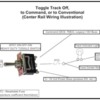Or vice versa...
I will be building a new layout, incorporating TMCC and DCS. It will be using post-war ZW and KW transformers for track power (with fuses and TVS protection)
I would also like to be able to operate "old school" using the handles of the transformers, whistle buttons, and Lionel sound activation button for the bell function and Polar Express car with announcement etc., both for operating some of my command engines, and post-war/non command equipment.
What is the best way to do this? Will the whistle button and sound activation button work through the TIU? Or is it better to install a system of transfer switches? If the latter is the way to go, can anyone provide a diagram for this so I don't have to reinvent the wheel?
Thanks,
Jim








